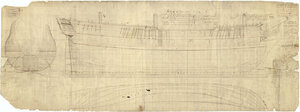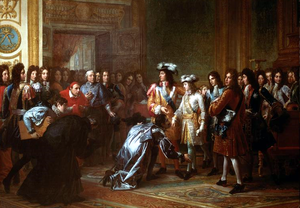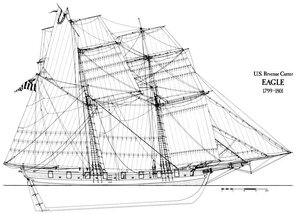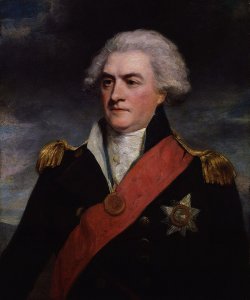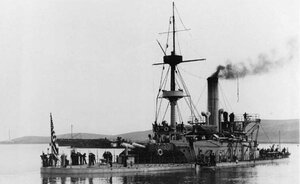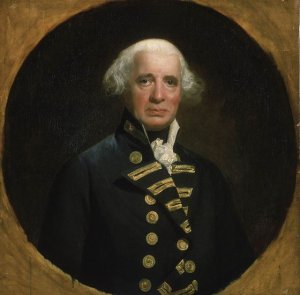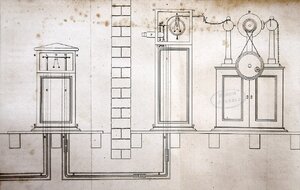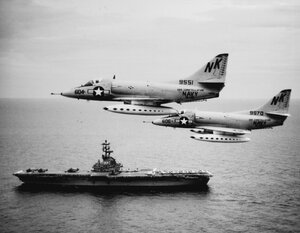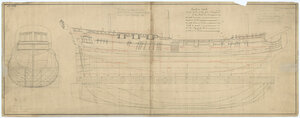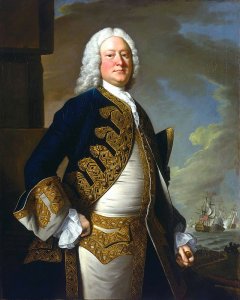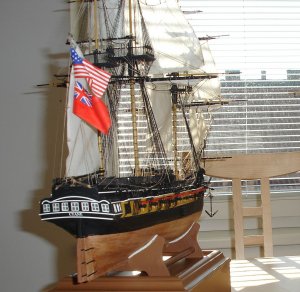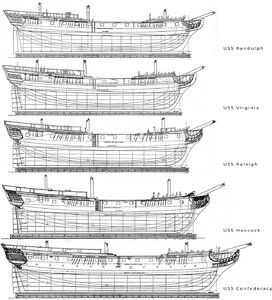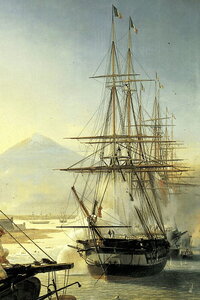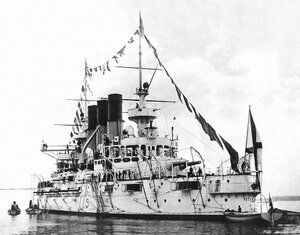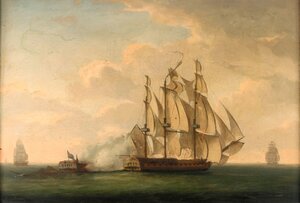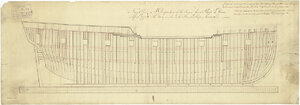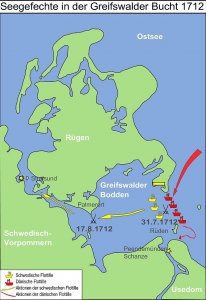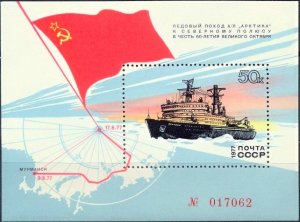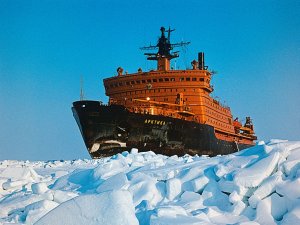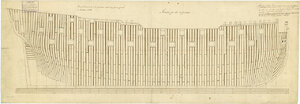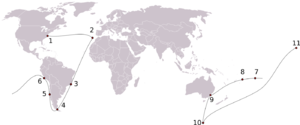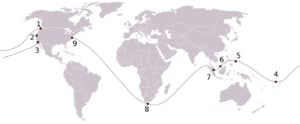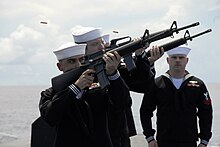Today in Naval History - Naval / Maritime Events in History
1st of August
please use the following link and you will find the details and all events of this day ..... in the following you will find some of the events
1620 - Speedwell leaves Delfshaven to bring pilgrims to America by way via England where she met Mayflower for their common journey
Speedwell was a 60-ton pinnace that, along with Mayflower, transported the Pilgrims and was the smaller of the two ships. A vessel of the same name and size traveled to the New World seventeen years prior as the flagship of the first expedition of Martin Pring.
Speedwell was built in 1577, under the name Swiftsure, as part of English preparations for war against Spain. She participated in the fight against the Spanish Armada. During the Earl of Essex's 1596 Azores expedition she served as the ship of his second in command, Sir Gelli Meyrick. After hostilities with Spain ended, she was decommissioned in 1605, and renamed Speedwell.

Model of a typical merchantman of the period, showing the cramped conditions that had to be endured
1704 - The Capture of Gibraltar by Anglo-Dutch forces of the Grand Alliance
occurred between 1–3 August 1704 during the War of the Spanish Succession. Since the beginning of the war the Alliance had been looking for a harbour in the Iberian Peninsula to control the Strait of Gibraltar and facilitate naval operations against the French fleet in the western Mediterranean Sea. An attempt to seize Cádiz had ended in failure in September 1702, but following the Alliance fleet's successful raid in Vigo Bay in October that year, the combined fleets of the 'Maritime Powers', the Netherlands and England, had emerged as the dominant naval force in the region. This strength helped persuade King Peter II of Portugal to sever his alliance with France and Bourbon controlled Spain, and ally himself with the Grand Alliance in 1703. Now with access to the Portuguese port of Lisbon the Alliance fleets could campaign in the Mediterranean, and conduct operations in support of the Austrian Habsburg candidate to the Spanish throne, the Archduke Charles, known to his supporters as Charles III of Spain.

Sketch of Gibraltar by an officer of Admiral Rooke's fleet on 1 August 1704
1761 – Launch of Essex class 64 gun third rate HMS Africa
HMS Africa was a 64-gun third rate Essex-class ship of the line of the Royal Navy, launched in 1761 and in active service during the latter half of the Seven Years' War against France and Spain.

1778 – Launch of French Magicienne class 32 gun frigate Magicienne
Magicienne was a frigate of the French Navy, lead ship of her class. The British captured her in 1781 and she served with the Royal Navy until her crew burned her in 1810 to prevent her capture after she grounded at Isle de France (now Mauritius). During her service with the Royal Navy she captured several privateers and participated in the Battle of San Domingo.

1798 - The Battle of the Nile (also known as the Battle of Aboukir Bay; French: Bataille d'Aboukir)
was a major naval battle fought between the British Royal Navy and the Navy of the French Republic at Aboukir Bay on the Mediterranean coast off the Nile Delta of Egypt from 1 to 3 August 1798. The battle was the climax of a naval campaign that had ranged across the Mediterranean during the previous three months, as a large French convoy sailed from Toulon to Alexandria carrying an expeditionary force under General Napoleon Bonaparte. The British fleet was led in the battle by Rear-Admiral Sir Horatio Nelson; they decisively defeated the French under Vice-Admiral François-Paul Brueys d'Aigalliers.
Bonaparte sought to invade Egypt as the first step in a campaign against British India, part of a greater effort to drive Britain out of the French Revolutionary Wars. As Bonaparte's fleet crossed the Mediterranean, it was pursued by a British force under Nelson who had been sent from the British fleet in the Tagus to learn the purpose of the French expedition and to defeat it. He chased the French for more than two months, on several occasions missing them only by a matter of hours. Bonaparte was aware of Nelson's pursuit and enforced absolute secrecy about his destination. He was able to capture Malta and then land in Egypt without interception by the British naval forces.


Battle of the Nile, 1 August 1798, Daniel Orme, 1805, National Maritime Museum. Nelson returns on deck after his wound is dressed.
1798 - french flagship Orient exploded
During the Battle of the Nile ......
At 21:00, the British observed a fire on the lower decks of the Orient, the French flagship. Identifying the danger this posed to the Orient, Captain Hallowell directed his gun crews to fire their guns directly into the blaze. Sustained British gun fire spread the flames throughout the ship's stern and prevented all efforts to extinguish them. Within minutes the fire had ascended the rigging and set the vast sails alight. The nearest British ships, Swiftsure, Alexander, and Orion, all stopped firing, closed their gunports, and began edging away from the burning ship in anticipation of the detonation of the enormous ammunition supplies stored on board. In addition, they took crews away from the guns to form fire parties and to soak the sails and decks in seawater to help contain any resulting fires. Likewise the French ships Tonnant, Heureux, and Mercure all cut their anchor cables and drifted southwards away from the burning ship. At 22:00 the fire reached the magazines, and the Orient was destroyed by a massive explosion. The concussion of the blast was powerful enough to rip open the seams of the nearest ships, and flaming wreckage landed in a huge circle, much of it flying directly over the surrounding ships into the sea beyond. Falling wreckage started fires on Swiftsure, Alexander, and Franklin, although in each case teams of sailors with water buckets succeeded in extinguishing the flames, despite a secondary explosion on Franklin.

Battle of the Nile, August 1st 1798 at 10 pm

The Battle of the Nile: Destruction of 'L'Orient', 1 August 1798, Mather Brown, 1825, National Maritime Museum
1798 – Death of French Admiral Vice-Admiral François-Paul Brueys d'Aigalliers during the Batlle of the Nile
Vice-Admiral François-Paul Brueys d'Aigalliers, Comte de Brueys (February 12, 1753 – August 1, 1798) was the French commander in the Battle of the Nile, in which the French Revolutionary Navy was defeated by Royal Navy forces under Admiral Horatio Nelson. The British victory helped to ensure their naval supremacy throughout the Napoleonic Wars. He was also a Freemason in the La Bonne Foi lodge at Montauban.
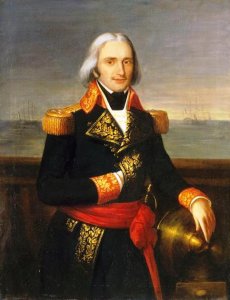
1st of August
please use the following link and you will find the details and all events of this day ..... in the following you will find some of the events
Naval/Maritime History - 27th of August - Today in Naval History - Naval / Maritime Events in History
28 July 1854 – USS Constellation (1854), the last all-sail warship built by the United States Navy, is commissioned USS Constellation is a sloop-of-war, the last sail-only warship designed and built by the United States Navy. She was built in 1854, using a small amount of material salvaged...
shipsofscale.com
1620 - Speedwell leaves Delfshaven to bring pilgrims to America by way via England where she met Mayflower for their common journey
Speedwell was a 60-ton pinnace that, along with Mayflower, transported the Pilgrims and was the smaller of the two ships. A vessel of the same name and size traveled to the New World seventeen years prior as the flagship of the first expedition of Martin Pring.
Speedwell was built in 1577, under the name Swiftsure, as part of English preparations for war against Spain. She participated in the fight against the Spanish Armada. During the Earl of Essex's 1596 Azores expedition she served as the ship of his second in command, Sir Gelli Meyrick. After hostilities with Spain ended, she was decommissioned in 1605, and renamed Speedwell.
Model of a typical merchantman of the period, showing the cramped conditions that had to be endured
1704 - The Capture of Gibraltar by Anglo-Dutch forces of the Grand Alliance
occurred between 1–3 August 1704 during the War of the Spanish Succession. Since the beginning of the war the Alliance had been looking for a harbour in the Iberian Peninsula to control the Strait of Gibraltar and facilitate naval operations against the French fleet in the western Mediterranean Sea. An attempt to seize Cádiz had ended in failure in September 1702, but following the Alliance fleet's successful raid in Vigo Bay in October that year, the combined fleets of the 'Maritime Powers', the Netherlands and England, had emerged as the dominant naval force in the region. This strength helped persuade King Peter II of Portugal to sever his alliance with France and Bourbon controlled Spain, and ally himself with the Grand Alliance in 1703. Now with access to the Portuguese port of Lisbon the Alliance fleets could campaign in the Mediterranean, and conduct operations in support of the Austrian Habsburg candidate to the Spanish throne, the Archduke Charles, known to his supporters as Charles III of Spain.
Sketch of Gibraltar by an officer of Admiral Rooke's fleet on 1 August 1704
1761 – Launch of Essex class 64 gun third rate HMS Africa
HMS Africa was a 64-gun third rate Essex-class ship of the line of the Royal Navy, launched in 1761 and in active service during the latter half of the Seven Years' War against France and Spain.
1778 – Launch of French Magicienne class 32 gun frigate Magicienne
Magicienne was a frigate of the French Navy, lead ship of her class. The British captured her in 1781 and she served with the Royal Navy until her crew burned her in 1810 to prevent her capture after she grounded at Isle de France (now Mauritius). During her service with the Royal Navy she captured several privateers and participated in the Battle of San Domingo.
1798 - The Battle of the Nile (also known as the Battle of Aboukir Bay; French: Bataille d'Aboukir)
was a major naval battle fought between the British Royal Navy and the Navy of the French Republic at Aboukir Bay on the Mediterranean coast off the Nile Delta of Egypt from 1 to 3 August 1798. The battle was the climax of a naval campaign that had ranged across the Mediterranean during the previous three months, as a large French convoy sailed from Toulon to Alexandria carrying an expeditionary force under General Napoleon Bonaparte. The British fleet was led in the battle by Rear-Admiral Sir Horatio Nelson; they decisively defeated the French under Vice-Admiral François-Paul Brueys d'Aigalliers.
Bonaparte sought to invade Egypt as the first step in a campaign against British India, part of a greater effort to drive Britain out of the French Revolutionary Wars. As Bonaparte's fleet crossed the Mediterranean, it was pursued by a British force under Nelson who had been sent from the British fleet in the Tagus to learn the purpose of the French expedition and to defeat it. He chased the French for more than two months, on several occasions missing them only by a matter of hours. Bonaparte was aware of Nelson's pursuit and enforced absolute secrecy about his destination. He was able to capture Malta and then land in Egypt without interception by the British naval forces.
Battle of the Nile, 1 August 1798, Daniel Orme, 1805, National Maritime Museum. Nelson returns on deck after his wound is dressed.
1798 - french flagship Orient exploded
During the Battle of the Nile ......
At 21:00, the British observed a fire on the lower decks of the Orient, the French flagship. Identifying the danger this posed to the Orient, Captain Hallowell directed his gun crews to fire their guns directly into the blaze. Sustained British gun fire spread the flames throughout the ship's stern and prevented all efforts to extinguish them. Within minutes the fire had ascended the rigging and set the vast sails alight. The nearest British ships, Swiftsure, Alexander, and Orion, all stopped firing, closed their gunports, and began edging away from the burning ship in anticipation of the detonation of the enormous ammunition supplies stored on board. In addition, they took crews away from the guns to form fire parties and to soak the sails and decks in seawater to help contain any resulting fires. Likewise the French ships Tonnant, Heureux, and Mercure all cut their anchor cables and drifted southwards away from the burning ship. At 22:00 the fire reached the magazines, and the Orient was destroyed by a massive explosion. The concussion of the blast was powerful enough to rip open the seams of the nearest ships, and flaming wreckage landed in a huge circle, much of it flying directly over the surrounding ships into the sea beyond. Falling wreckage started fires on Swiftsure, Alexander, and Franklin, although in each case teams of sailors with water buckets succeeded in extinguishing the flames, despite a secondary explosion on Franklin.
Battle of the Nile, August 1st 1798 at 10 pm
The Battle of the Nile: Destruction of 'L'Orient', 1 August 1798, Mather Brown, 1825, National Maritime Museum
1798 – Death of French Admiral Vice-Admiral François-Paul Brueys d'Aigalliers during the Batlle of the Nile
Vice-Admiral François-Paul Brueys d'Aigalliers, Comte de Brueys (February 12, 1753 – August 1, 1798) was the French commander in the Battle of the Nile, in which the French Revolutionary Navy was defeated by Royal Navy forces under Admiral Horatio Nelson. The British victory helped to ensure their naval supremacy throughout the Napoleonic Wars. He was also a Freemason in the La Bonne Foi lodge at Montauban.




